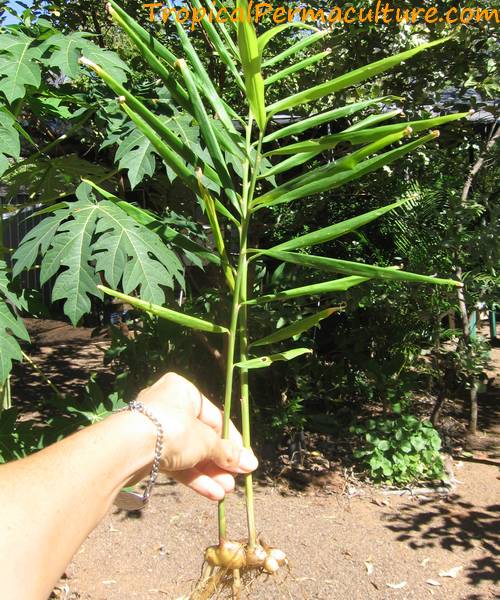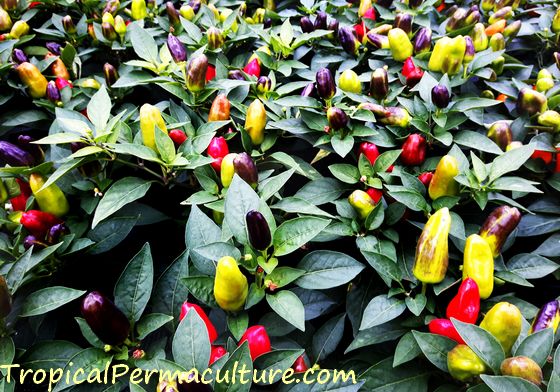Growing Comfrey (Symphytum spp.)
How To Grow Comfrey And Its Many Uses And Benefits
Growing comfrey is easy. Maybe too easy. Rather than asking how to grow comfrey, the better question may be how to stop comfrey from taking over your garden!
Then again, comfrey is such a useful plant, I am happy to let it spread and grow wherever it is happy, i.e. everywhere.
On this page we will look at what comfrey likes and dislikes, where and how to grow it, and its many uses and benefits.
(Always remember, in permaculture we want everything in our garden to have as many uses as possible.)
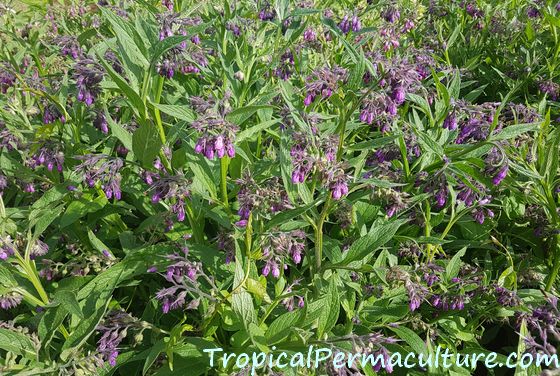 A large patch of comfrey.
A large patch of comfrey.What Is Comfrey And What Does It Look Like
Comfrey is a hardy herb belonging to the borage family (Boraginaceae). While borage is an annual, comfrey is a perennial plant.
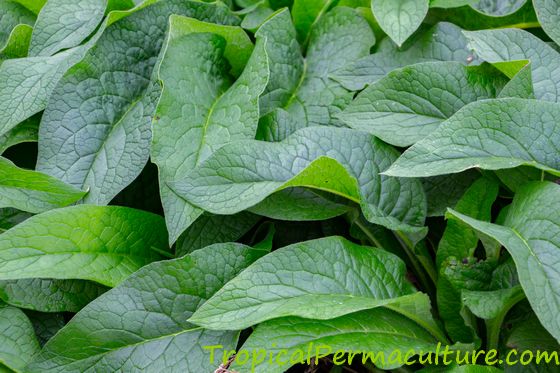 Comfrey leaves
Comfrey leaves
Comfrey grows deep tap roots, large, pointed, hairy leaves and bunches of drooping bell shaped flowers in various shades of blue, purple, pink and cream. Very pretty and very popular with beneficial insects.
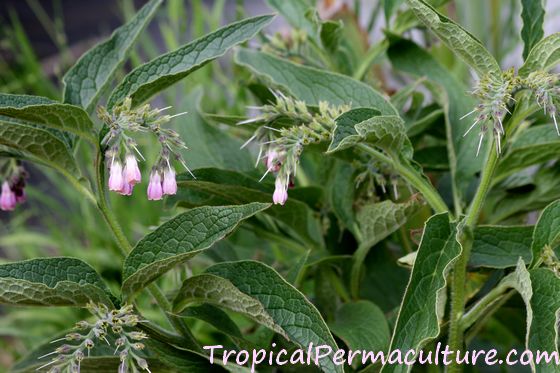 Rough comfrey (Symphytum asperum) flowering in a light pink shade. Usually, its flowers are blue.
Rough comfrey (Symphytum asperum) flowering in a light pink shade. Usually, its flowers are blue.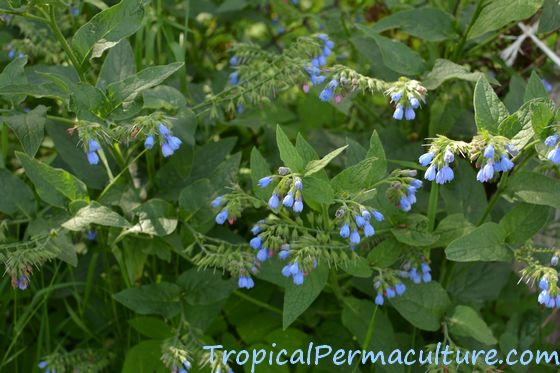 The blue flowers of caucasian comfrey, Symphytum caucasicum.
The blue flowers of caucasian comfrey, Symphytum caucasicum.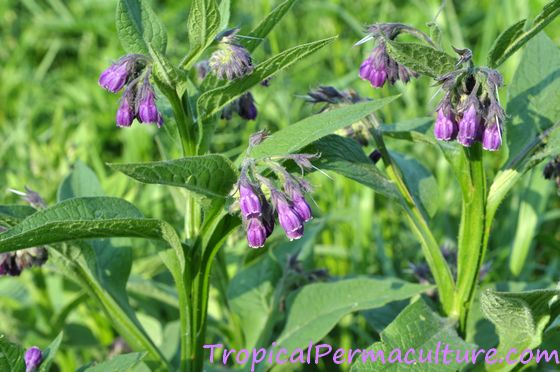 True comfrey (Symphytum officinale) will most often have purple flowers.
True comfrey (Symphytum officinale) will most often have purple flowers.
Beware comfrey's vigorous growing habit and size! A happy, mature comfrey plant can measure a metre (over 3 feet) in height and across.
What Comfrey Likes And Dislikes
Comfrey is exceptionally hardy and grows happily in a wide variety of conditions.
Comfrey easily withstands freezing winters and can also grow in subtropical and tropical areas. However, it rarely flowers in those regions as it is the winter chill that induces the flower.
Having said that, even without flowers, comfrey is still an immensely useful plant in any permaculture garden. (Well, in any garden, really!) We'll get to that in more detail later.
In temperate climates with freezing winters it will completely die back in the fall/winter and then grow back (a lot bigger) the next spring.
Comfrey grows in full sun or partial shade. As so often, the hotter your climate, the more your plants will appreciate a little shade, especially in the afternoon. Also, the more compact your soil, the more shade your comfrey will want. Ideally your comfrey should get at least three hours of direct sunlight.
Thanks to its deep tap roots comfrey will still do well during dry spells (once established, that is) but grows best with steady moisture. If it wilts, give it water. It'll quickly recover.
As for soils, comfrey isn't fussed. Heavy clay to light sand, slightly acidic to slightly alkaline, comfrey takes it all in stride. Like many garden plants it does best in a rich loam with high organic matter content and the richer and moister the soil the faster it will grow.
Comfrey isn't usually bothered by pest or diseases. Snails and slugs like it, not least because of its dense growing habit and the moist shelter they find underneath it. But a vigorously growing comfrey plant doesn't care when a few slugs feast on it.
A struggling, young plant under heavy pressure from slugs and under moist conditions may need a little help though. Once it has developed a decent size it can fend for itself.
Comfrey Varieties
Over 30 known comfrey (Symphytum) varieties exist, but only several are cultivated and only two are widely grown. Which species you have access to depends on where you live, as different varieties are grown in different parts of the world.
S. officinale is common in Europe where it grows naturally in large clumps along rivers and creeks, the edges of forests and in moist meadows. Also known as true or common comfrey, it's the variety that grows in most European gardens. This is the variety that is used medicinally. If growing it in the garden be aware that it self seeds prolifically.
S. asperum is also native to Europe. It is called rough comfrey because of its hairy leaves. It is not usually cultivated.
(It grows in my garden. I don't know where it came from. Then again, I have no idea how the true comfrey got here either. It's everywhere now.)
The comfrey that you see in most American gardens is a hybrid of these two European species, called S. x uplandicum, Bocking 14, or Russian comfrey. It is naturally sterile (causes no problems with self seeding), has purple flowers, and grows up to 6 feet tall.
Other, less common and more ornamental varieties that you may be able to find in nurseries or online are:
S. caucasicum, known as Caucasian comfrey or blue comfrey (the flowers are pink when they emerge and then turn blue),
S. grandiflorum known as large flowered comfrey (cream to white flowers, larger than other comfrey flowers),
S. rubrum or red comfrey with a beautiful deep crimson red flower,
and Axminster Gold, a variety with green and yellow variegated leaves.
How To Grow Comfrey
As I said in the very beginning, growing comfrey is ridiculously easy:
Find a piece of root or a plant somewhere, put it in the ground, done.
And in a few years time start wondering how on earth you will stop it from taking over your entire garden...
Ok, lets look at this in more detail.
Before you do anything, think. And then think again, about where exactly you want to grow your comfrey. Remember that it will grow into a very large bush and be aware that, once established, it is almost impossible to get rid of it again. Unless you have a sterile variety it will also self seed and spread.
Once you know where to grow it, the best way to get started growing comfrey is to buy, beg or steal either a young plant or a root cutting somewhere. Check with your friends, neighbours, your nursery or garden centre of choice.
To obtain a root cutting you simply dig away the soil around a mature plant to expose the roots and cut off a small bit (or several bits) of the root. Make the cuttings 5-15 cm (2-6 inches) in size.
Put the root cuttings in the ground horizontally, 5-10 cm (3 inches) deep. The sandier the soil, the deeper they should go, in heavy clay soils keep them closer to the surface.
Now keep the soil moist at all times until the plant grows (3-6 weeks). Continue to provide the little plant with enough moisture until it is well established and growing vigorously.
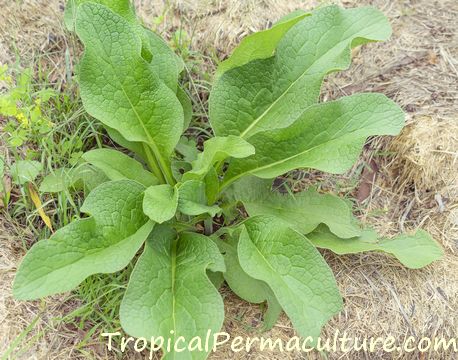 A happy young comfrey plant.
A happy young comfrey plant.
After that your comfrey will not need any additional care, not even fertilizer, though you can initially help it along with some compost and mulch if your soil is poor. (It does need a fair bit of nitrogen to grow fast.)
Generally comfrey is very good at finding the nutrients it needs itself, because the tap roots grow deep down into the subsoil and mine it for whatever comfrey needs. (We will return to this later when we talk about the uses of comfrey.)
What I said above also applies to planting a young plant from the nursery, except you probably shouldn't place it horizontally.
It is also possible to divide and transplant older plants. You can dig up a plant or part of it, chop it into bits vertically, trim the roots back to about 10 cm (4 inches), also trim off the leaves, and replant the bits. The trimmed off roots can be used for root cuttings. The crown divisions will grow faster than the root cuttings, you should see fresh growth in one to two weeks.
The timing of planting is not critical. You can plant comfrey any time of the year as long as the ground is not frozen. The ideal time would be spring in cooler climates and the wet season in tropical climates. If the time is not ideal, it doesn't matter.
If you want to start your comfrey cuttings in a pot, make sure it is large enough, especially deep enough! And transplant once the plant grows. Comfrey will ultimately not be happy as a pot plant.
Growing comfrey from seed is a possibility but seeds need winter chill to germinate, and even then it may take them a couple of years. If you want to try growing them from seed, sow it in the fall, a couple of centimetres (half an inch) deep. And then be very patient.
(Isn't it funny how growing seeds from a seed packet always seems so much fuss, while allowing plants to self seed seems to lead to every single damn seed growing wherever it falls? Certainly true for comfrey...)
Managing Comfrey In Your Garden
Usually now would follow the section on "Caring For...". You don't need to care for comfrey, but if in five or ten years time you still want to be able to grow other things besides comfrey in your garden, you do need to manage it a bit. This is especially true if you grow the self seeding true comfrey, S. officinale.
Weeds don't stand a chance next to comfrey. It grows much faster and bigger, so no need to worry there. (But do worry if you planted it too close to something else that you care about.)
Even deer don't seem to like comfrey much.
Comfrey flowers during spring. You can keep it flowering through the whole year if you regularly cut it back, either when it starts to keel over (which it'll do once it is done flowering) or sooner. You can cut back individual stalks or cut the whole plant down to the ground. It will quickly regrow and flower again. If you cut it early enough you can reduce its spread via seeds.
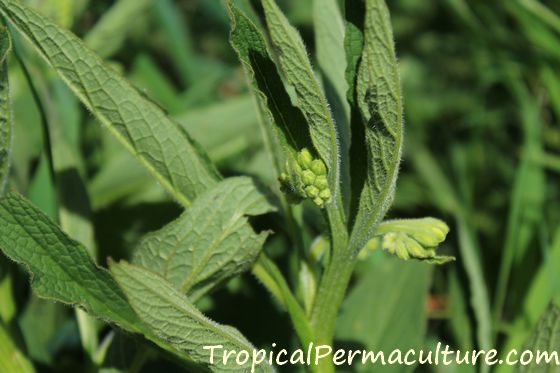 A comfrey stalk is just about to flower.
A comfrey stalk is just about to flower.
The cut leaves and stalks make great, GREAT mulch and also a perfect compost ingredient, but keep in mind that they may contain seeds.
No matter what variety you have, be careful when digging around your comfrey plants. Every little bit of root and even the bottoms of stems can grow a new plant.
If plants crop up in places where you don't want them, and you catch them early enough, you can either pull them up or, if that doesn't work, cut, cut, cut them again, never letting them grow, hoping they'll eventually run out of energy to regrow.
Good luck with that if you didn't catch them early enough. Then they'll probably regrow eventually anyway, but you should be able to keep them small and not bothering others.
The only way to permanently get rid of an established comfrey plant (apart from letting it dry out in a climate where it never rains) is to place something over the top (after cutting it to the ground, obviously) that prevents it from regrowing.
The ideal solution in my opinion would be to use a system called sheet mulching. (Heard of lasagna gardening?) You place several layers of cardboard over the comfrey, and on top of that you thickly layer compost and mulch and plant something into that. More useful than placing a slab of rock or ugly matting or similar though ultimately you may need to resort to something like that.
In the chapter on growing comfrey I urged you to think hard about where you want to grow comfrey. I think ultimately comfrey is best suited to large, natural gardens, where rather than growing an individual, neat plant you can establish a comfrey patch, or set a larger area aside where comfrey can grow widely and naturally.
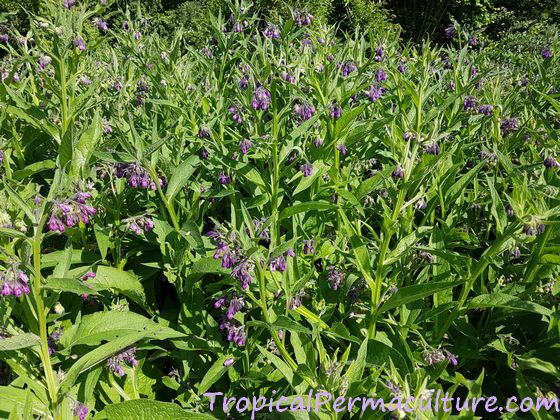 Comfrey. Lots of comfrey.
Comfrey. Lots of comfrey.
We'll talk next about comfrey's many uses and that may give you some ideas on how and where you can best incorporate it into your garden.
Comfrey Uses And Benefits In The Garden
Permaculture and organic gardeners grow comfrey for many reasons, the most important of which is that comfrey can be used in many ways to increase soil quality and fertility and to fertilize plants directly.
We already spoke about the deep tap root that comfrey grows. Not only can those deep roots break up heavy clay soils or hard layers in the subsoil, they also "mine" the deeper soil layers for nutrients, bring those nutrients to the surface and concentrate them in the leaves.
The leaves are especially high in nitrogen and potassium (even more so than for example kelp meal or composted manure) as well as containing very good amounts of phosphorus, calcium and magnesium.
The leaves can be cut and used in many ways. (From the second year onwards, cut individual stalks and leaves as needed or cut the whole plant to the ground up to 4-5 times a year, 2-3 times in cooler climates.)
- The easiest and most popular way is to use comfrey leaves as mulch. The least amount of work is the so called "chop and drop" mulch, i.e. use the leaves right where the comfrey grows. One good example is growing it under fruit trees and using it there but you can grow it near anything that you think will appreciate copious amounts of nutrient rich mulch.
Alternatively you can of course carry it to where you need it, or shred the leaves to use them around daintier plants. You can also work the shredded leaves into the ground if you insist on a neat garden.
This mulch is not only beneficial because of the nutrients, it also improves the soil because you are adding large amounts of biomass which will feed the soil microbes and worms. - Another option is to dry the leaves and to sprinkle the shredded, dry comfrey leaves on the soil like other soil amendments. This has the advantage that you have your fertilizer handy any time you need it
(Mind you, I've never used comfrey in this way. It sounds like work. How would you even dry so many big leaves properly to get a meaningful amount of powder in the end? But I read an article from an author who swears by this.) - You can also turn comfrey into a liquid fertilizer. (Yes, also requires a little work.) Half fill a bucket or barrel with cut up leaves, cover them with water (you may need to weigh the leaves down somehow), put on a lid to contain the stink (it's bad) and let the brew ferment for several weeks. Six weeks is ideal, but you can use your "comfrey tea" much sooner if you urgently need it.
For use, dilute a strong six week brew 1:15. If using it after a shorter brewing time or if you had a lot of water in it to start with, you don't need to dilute it as much if at all. You need to use your own judgement here.
The liquid can be added to the soil around plants that need a boost or it can be sprayed as a foliar feed. In the latter case you need to make sure to strain it well. The leftover stinky leaf mush you can add to your compost pile or you use it to side dress plants, though maybe not those next to your kitchen door.
By the way, if using comfrey tea as a foliar spray it is said to help against powdery mildew by inhibiting the spores from germinating.
And it will help with any and all diseases anyway by making your plants stronger, no matter which way you use it.
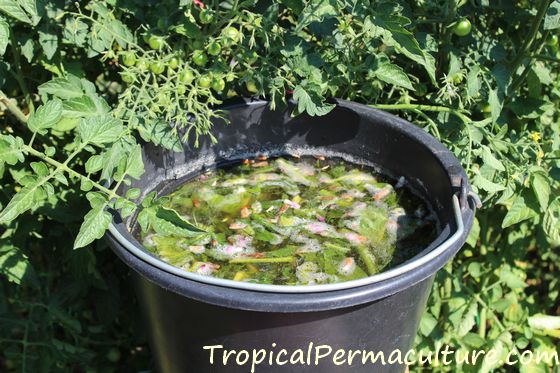 A bucket of freshly made liquid comfrey fertilizer sitting next to the tomato patch where it will eventually be used.
A bucket of freshly made liquid comfrey fertilizer sitting next to the tomato patch where it will eventually be used.- One more way to use cut leaves is to add them to a compost pile directly to speed up the composting process. Because the leaves are high in nitrogen they can improve the nitrogen : carbon ratio if your compost contains a lot of dry and stalky material as is often the case.
(Beware if your compost contains mostly moist, green materials. Adding more of the same will slow the process down rather than accelerating it.) - Another potential use is as a snail/slug lure or trap. Freshly cut comfrey leaves placed on the soil in the evening may keep the slugs away from your more precious and sensitive plants. In the morning the slugs will be hiding under (what's left of) the leaves and you can collect and dispose of them. (If you have no comfrey leaves handy yet, in my experience the outer leaves of cauliflower also work really well for this.)
- And you can add cut up leaves to the bottom of a planting hole when planting something. They'll act as a slow release fertilizer.
- Also, every time you cut a comfrey plant down, some of its roots will die back as they are not currently needed. They will regrow as the plant regrows, but the dead and decomposing roots deep below improve the deeper layers of the soil that we can not usually influence directly. Over time you will develop a much deeper, richer, soil than you started out with.
- Because of its dense, vigorous growing habit comfrey can be planted in a row as an effective weed barrier. Even running grasses won't stand a chance. Mind you, you need a pretty big garden to plant it in that way.
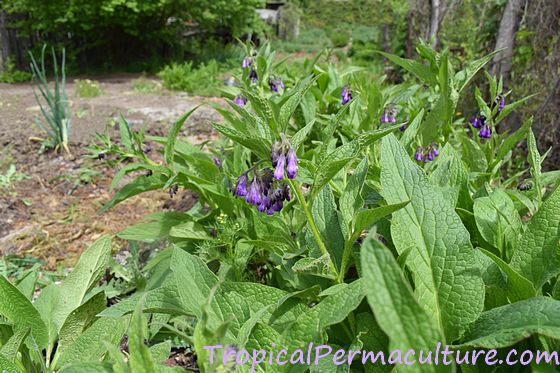 A row of comfrey growing as a weed barrier and mulch source next to a fallow vegetable garden.
A row of comfrey growing as a weed barrier and mulch source next to a fallow vegetable garden.- If your garden is on a slope, comfrey will also work well to capture nutrient run off say from a compost pile or chicken pen if you plant it below that, or simply plant it at the bottom of your garden to capture anything that comes down.
- And last but not least, there are the comfrey flowers. Not only are they very pretty but they are also very popular with pollinating and predatory insects, attract many of them, and you can never have too many of those in a garden!
If you want the flowers but also want plenty of mulch, grow many plants and cut them at different times so you always have some flowers.
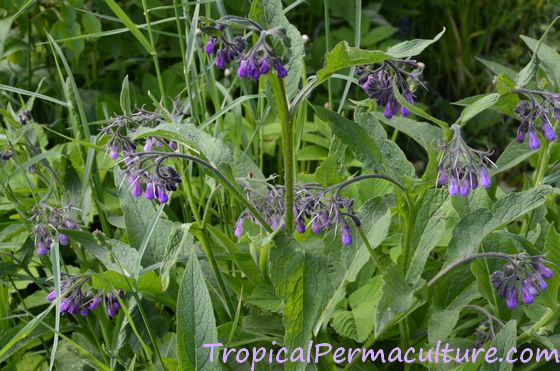
Comfrey has also been used for a long time as a fodder crop for chickens, rabbits, pigs and ruminants. There even is a variety that has been bred specifically for use as fodder, though I don't know what it is called.
However, as you'll learn below, comfrey does contain potentially harmful chemicals so I'd do more research before using it in that way and also go easy with it.
Medicinal Uses Of Comfrey
We know that comfrey has been used medicinally since at least 400 BC. Greeks and Romans used it and it was probably first brought to America for medicinal use. Comfrey is still used today, both internally and externally.
I will not advise you on internal use. In fact, I advise against it unless you really, REALLY know what you are doing.
Yes, comfrey has been used (and still is by some herbalists) to help with bronchitis, ulcers, GI issues and other ailments, but comfrey contains toxic pyrrolizidine alkaloids. It has been shown to cause liver damage in both humans and livestock (hence my above warning about using it as a fodder crop). It has also been shown to be carcinogenic in laboratory animals.
Luckily, this isn't relevant to external use. Comfrey contains another substance called allantoin which encourages cell proliferation, i.e. the growth and multiplying of cells. Because of that stimulation of cell growth comfrey can speed up the healing of wounds and burns, tendon strains, torn cartilage and broken bones. (Which led to its colloquial name "knitbone".)
Comfrey is also well known to be soothing to and speed up the healing of bruises and sprains. Apparently it can also reduce scarring if used during the healing process.
The quickest way to use it is to simply make a poultice of mashed leaves and apply it to your bruise, sprain, or any cuts or scrapes.
You can also make a quick extract from the roots: Clean the roots and cut them into bits, then cover with boiling water using one part roots to ten parts water. Let the mixture steep for 15 minutes. After straining it you can soak a bandage or compress in it and apply to your injury.
(Roots are best harvested in the fall, cleaned, sliced and dried to preserve them for when you need them.)
If you know how to or want to experiment with making your own comfrey salve you can do so by steeping mashed leaves in a carrier oil (olive is common and works well, I prefer almond, but any neutral carrier oil will do.) Let it sit in a dark location for four to six weeks, shaking it regularly. Eventually strain the mix, heat it, add beeswax in a 1:4 ratio, and a few drops of vitamin E as a preservative. If you like you can also add essential oils for fragrance. Then pour it into jars, let it cool, and store it somewhere cool and dark.
Or be lazy and boring like me and buy a comfrey salve online.
(I swear by it, by the way. The comfrey salve that is, not the online buying.)

